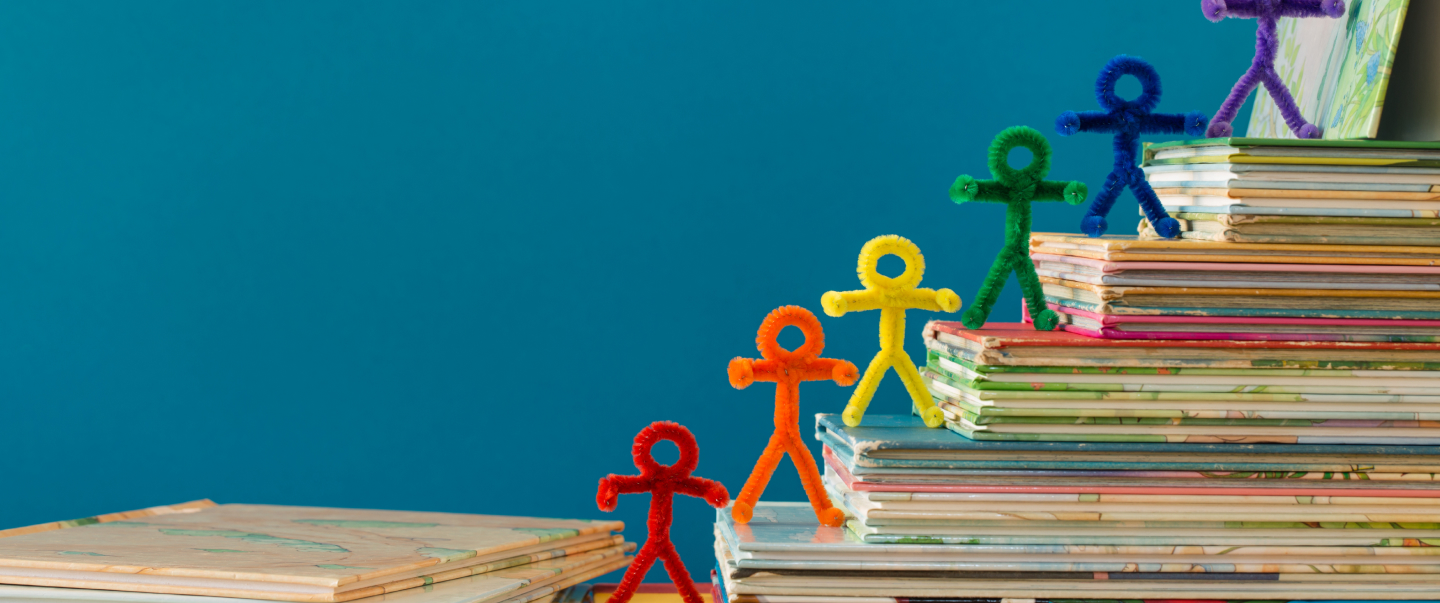Language Arts
CKLA Preschool
Core Knowledge Language Arts is a comprehensive language arts curriculum program for students in Preschool.
While teaching skills in reading, writing, listening, and speaking, Core Knowledge Language Arts (CKLA) also builds students’ knowledge and vocabulary in literature, history, geography, and science. The curriculum covers concepts specified in the Core Knowledge Sequence.
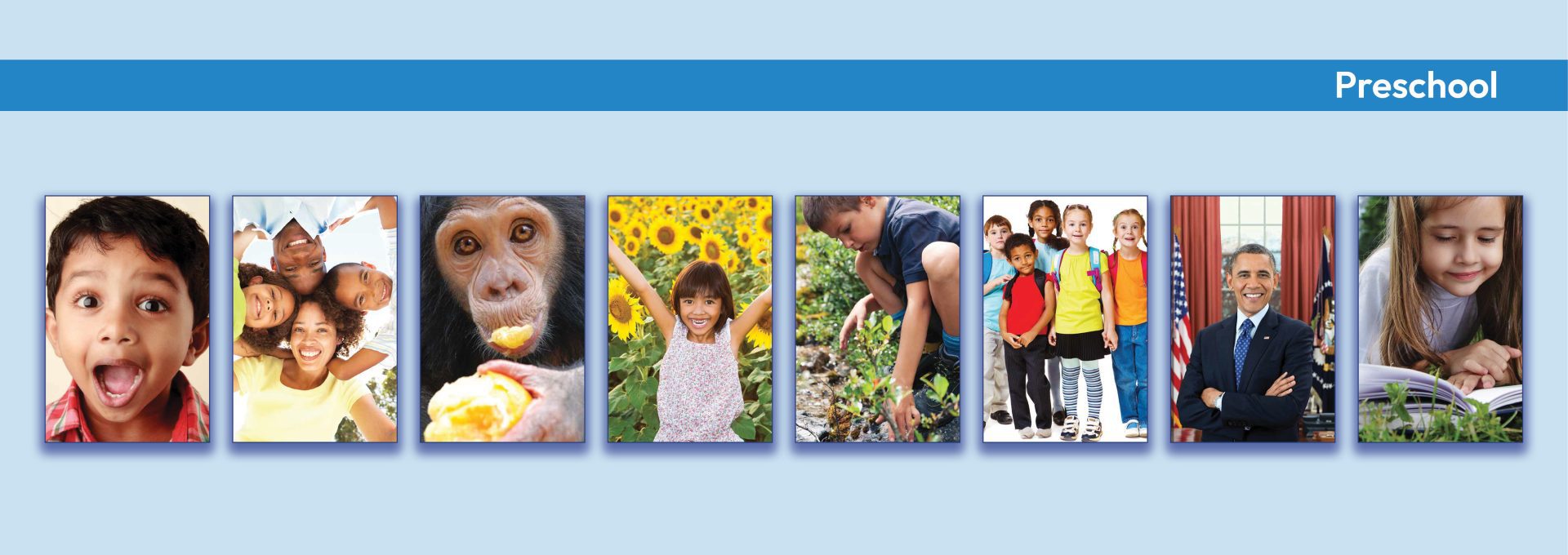
This comprehensive Teacher Guide specifies learning objectives and provides background information, daily lesson plans, read-alouds, assessments, and other resources for teaching the domain.
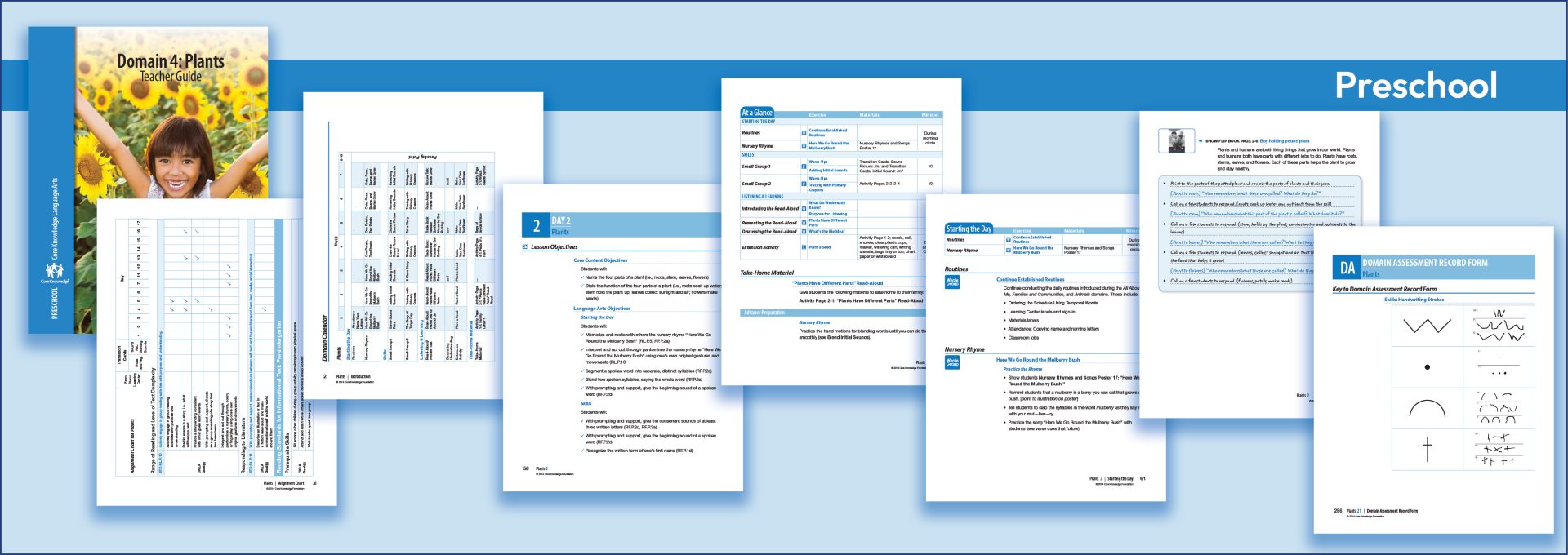
The Activity Pages reinforce the content and skills taught in each domain. Practice opportunities are provided both in and out of the classroom.
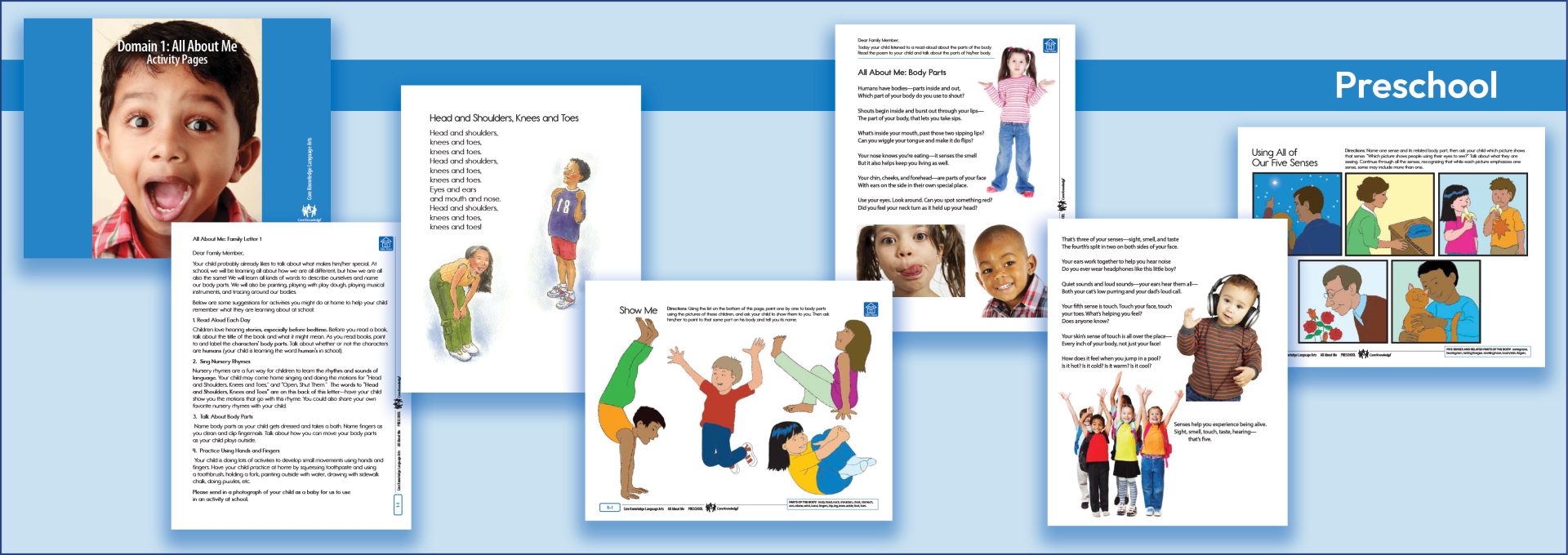
Each Flip Book contains a sequenced collection of images that accompany the Listening & Learning read-alouds. The engaging visuals reinforce students’ understanding of concepts and promote engagement with the text.

Image Cards are used to reinforce and deepen students’ understanding of the information covered in the domain. They are primarily used during Extension Activities. Common exercises include sorting, retelling, and sequencing.
Transition Cards reinforce content and skills as students move between activities. Some of these cards may be used across multiple domains.
Learning Center Cards provide teachers with suggested questions and prompts in order to facilitate language and promote student-to-student interaction.
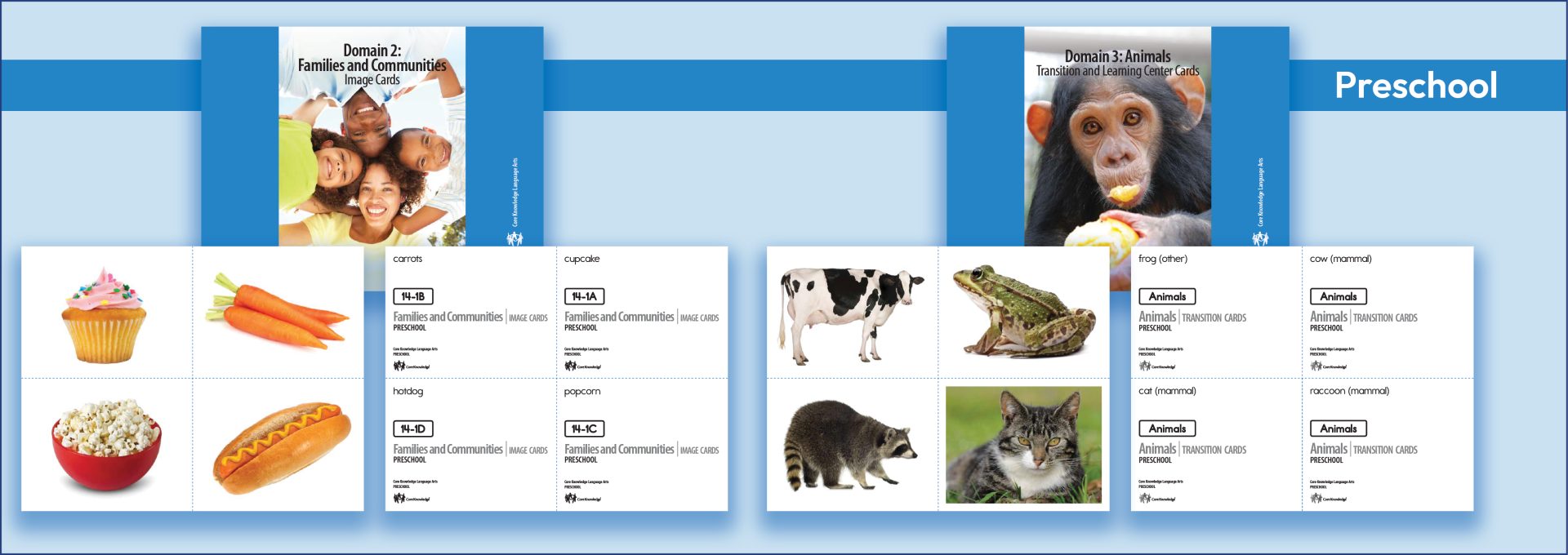
Nursery Rhymes and Song Posters: Nursery Rhymes and Song Posters display text and images from traditional rhymes and songs. These posters are used during circle time and small-group activities as a means of familiarizing students with the structure and sounds of oral language.
General Overview: The General Overview of Core Knowledge Language Arts Preschool (CKLA Preschool) describes the design of the program and its various components. In addition, the resource offers suggestions around facilitating language as well as supporting the needs of diverse learners during CKLA instruction.
Interspersed Domains: The lessons in the interspersed domains are taught throughout the school year, interspersed among the lessons of the other domains.
Social Skills Posters: Attractive full-color posters that illustrate important social skills to be taught and reinforced in preschool classrooms. The front of each poster features photographs of preschool children modeling the specific social skill.
CKLA Grades K–3
Core Knowledge Language Arts is a comprehensive language arts curriculum program for students in Grade K–3.
While teaching skills in reading, writing, listening, and speaking, Core Knowledge Language Arts (CKLA) also builds students’ knowledge and vocabulary in literature, history, geography, and science. The curriculum covers concepts specified in the Core Knowledge Sequence.

Read-Aloud Anthology: This comprehensive Teacher Guide specifies learning objectives and provides background information, daily lesson plans, read-alouds, assessments, and other resources for teaching the domain.
Read-Aloud Supplemental Guide: Designed primarily to provide instructional scaffolding resources for reading specialists, special education teachers, and ESL teachers, the online-only Supplemental Guide offers activities that the general classroom teacher may use as needed. Resources include adapted read-alouds, engagement supports, Vocabulary Charts, Multiple Meaning Word Activities, Syntactic Awareness Activities, and Vocabulary Instructional Activities.
Image Cards: Image Cards are used to reinforce and deepen students’ understanding of the information covered in the domain. They are primarily used during Extension Activities. Common exercises include sorting, retelling, and sequencing.
Flip Book: Each Flip Book contains a sequenced collection of images that accompany the Listening & Learning read-alouds. The engaging visuals reinforce students’ understanding of concepts and promote engagement with the text.
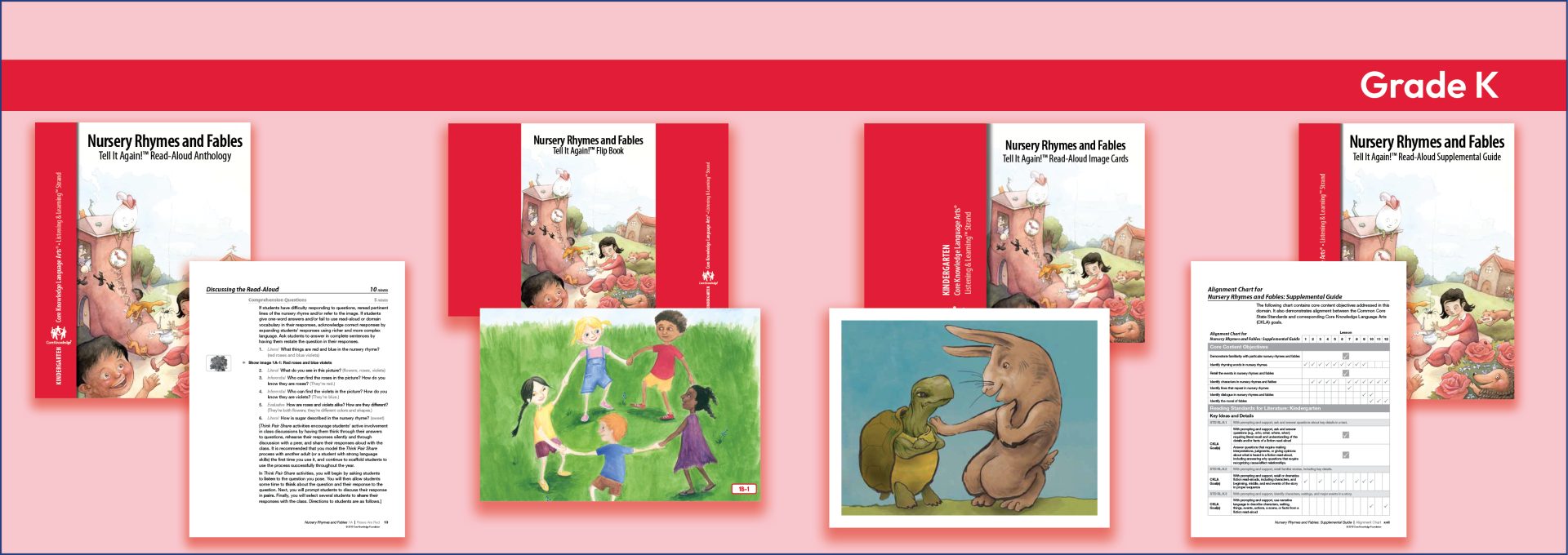
Student Workbook: Student Workbooks contain activity pages that provide practice or reinforcement of skills taught in the unit. Graphic organizers, assessment tasks, and take home activities are also included in the workbooks.
Student Reader: These 100% decodable texts provide children an authentic reading experience and reinforce their sense of success by eliminating the distraction of encountering untaught spelling patterns. The texts are written in the style of chapter books to inspire children to want to read more.
Teacher Guide: This comprehensive Teacher Guide specifies learning objectives and provides background information, daily lesson plans, assessments, and other resources for teaching the Skills unit.
Assessment and Remediation Guide: The Assessment and Remediation Guide provides for re-teaching and reinforcement of grade-level objectives that were not mastered in Skill Strand lessons. This online-only resource assists teachers with determining students’ needs, selecting activities and materials that target those needs, adjusting instructional difficulty, and monitoring progress. Use of this resource creates continuity between core classroom and support instruction.

Teacher components:
Large Card Sets: Large Cards are used in chaining exercises to help students practice phonemic spelling while also offering them an opportunity for movement
Sound Poster Sets: The Sound Posters provide a visual reminder of the code knowledge students have been taught, and are a useful reference for spelling and writing. They are used in conjunction with the Sound Cards in Units 3–5, 7–8, and 10 of the Kindergarten Skills strand.
Sound Cards: The Sound Cards include a spelling and a visual representation of a sound. They are used in conjunction with the Sound Posters in Units 3–5, 7–8, and 10 of the Kindergarten Skills strand.
Student components (Kindergarten):
Student Chaining Folders: Student Chaining Folders provide spelling practice. Students arrange Small Letter Cards on these folders in order to spell words comprised of sound spellings that they have been taught.
Small Letter Card Sets: Small Letter Cards provide spelling practice. Students arrange the cards on their Chaining Folders in order to spell words with the sound spellings that they have been taught.
Blending Picture Cards: The Blending Picture Cards are used as part of early blending practice. They are designed to provide a visual cue, which supports students with blending the names of various objects.
Student components (Grades 1-3):
Consonant Code Flip Book: The Consonant Code Flip Book is used to introduce or review consonant sound-spelling correspondences. It can also be utilized at any time to support individuals or groups in need of targeted remediation and practice.
Vowel Code Flip Book: The Vowel Code Flip Book is used to introduce or review vowel sound-spelling correspondences. It can also be utilized at any time to support individuals or groups in need of targeted remediation and practice
Spelling Cards: Spelling Cards are used in conjunction with the Consonant and Vowel Flip Books to record student progress. Teachers affix the spelling to the corresponding chart when a new sound-spelling is introduced.
Individual Code Charts: Students use the Individual Code Chart to record the sound-spelling correspondences they have learned. They are encouraged to refer to the Individual Code Chart when reading and writing independently.
Wiggle Cards: Each Wiggle Card contains a sentence or phrase comprised of letter-sound correspondences taught in earlier grades. The card directs students to move or act in a certain way. Along with providing decoding practice, Wiggle Cards afford opportunities for kinetic activity.
Assessment and Remediation Guide: The Assessment and Remediation Guide provides re-teaching and reinforcement of grade-level objectives that were not mastered in Skill Strand lessons. This online-only resource assists teachers with determining students’ needs, selecting activities and materials that target those needs, adjusting instructional difficulty, and monitoring progress. Use of this resource creates continuity between core classroom and support instruction
Fluency Packet: The Fluency Packet provides opportunities for students to practice reading with fluency and expression. This online-only resource contains poetry, fiction, and nonfiction, as well as Reader’s Theater selections.

Vocabulary Cards: Vocabulary Cards reinforce vocabulary listed in the glossary of the unit’s Student Reader.
Vocabulary Image Cards: Image Cards are used to reinforce and deepen students’ understanding of the vocabulary listed in the Student Reader glossary.
Timeline Cards: The 20 Timeline Cards are displayed in order to support students with contextualizing the time period of the War of 1812.

Big Book: Big Books are used to engage students in the reading process. For example, during story demonstration lessons, teachers use Big Books to model important concepts of print, including text directionality, reading from left to right, attentiveness to punctuation, and highlighting the different parts of a book.
Supplemental Reader: A Supplemental Reader is used at the teacher’s discretion throughout the school year. Corresponding activity pages are designed for students to complete independently.
Supplemental Workbook: This Supplemental Skills Workbook contains activity pages that accompany the stories in More Classic Tales, the Supplemental Reader for this unit. Each activity is identified by its chapter number. There are two pages for each chapter; the first consists of comprehension questions and the second is a copy of the chapter for students to take home.
Workbook Answer Key: This Workbook Answer Key for More Classic Tales contains samples of correctly completed worksheets that accompany More Classic Tales for Unit 1.
CKLA Grades 4-5
Core Knowledge Language Arts is a comprehensive language arts curriculum program for students in Grades 4–5.
While teaching skills in reading, writing, listening, and speaking, Core Knowledge Language Arts (CKLA) also builds students’ knowledge and vocabulary in literature, history, geography, and science. The curriculum covers concepts specified in the Core Knowledge Sequence.

The Student Readers include complex text and prepare students for increased vocabulary and syntax demands in later grades.

The Activity Book contains Activity Pages to accompany the lessons from the Teacher Guide.

The Teacher Guide specifies learning objectives and provides background information, daily lesson plans, assessments, and other resources for teaching the units.

The Digital Components contain various posters, charts, and graphic organizers for use during lessons.
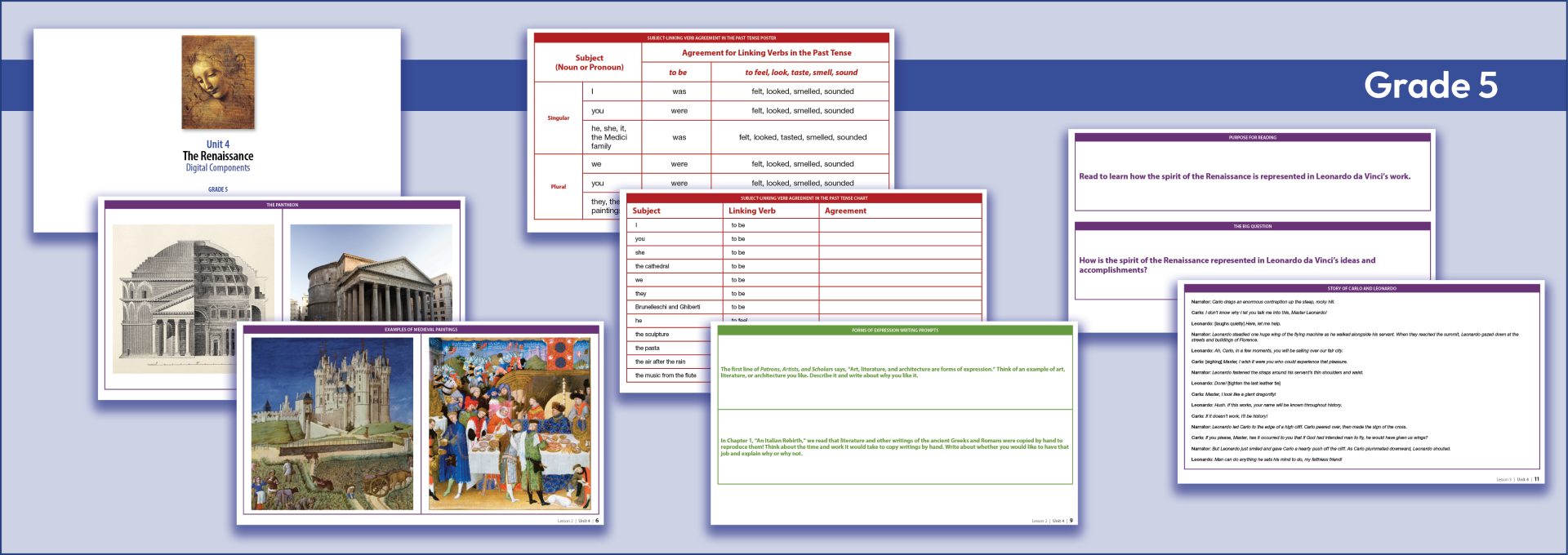
The Alignment Chart indicates which lessons address content from the Common Core State Standards.
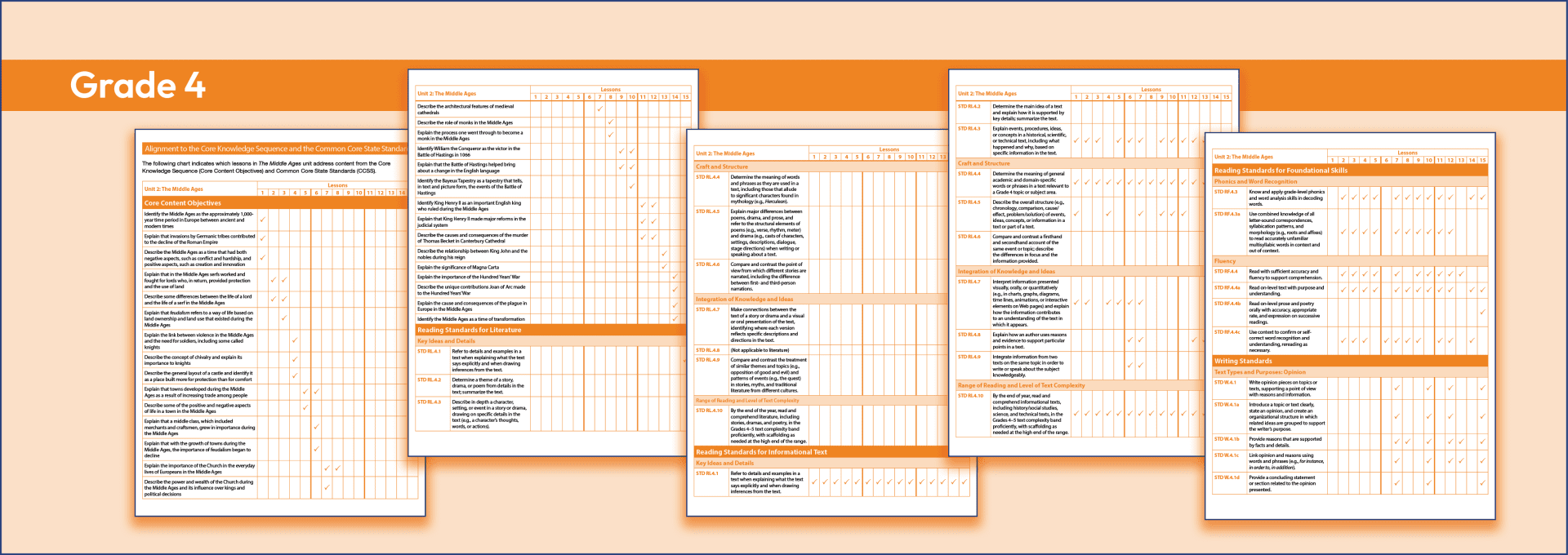
CKLA Grades 6-8
Core Knowledge Language Arts is a comprehensive language arts curriculum program for students in Grade 6–8.
While teaching skills in reading, writing, listening, and speaking, Core Knowledge Language Arts (CKLA) also builds students’ knowledge and vocabulary in literature, history, geography, and science. The curriculum covers concepts specified in the Core Knowledge Sequence.

The Student Reader includes complex text and prepares students for increased vocabulary and syntax demands in later grades.
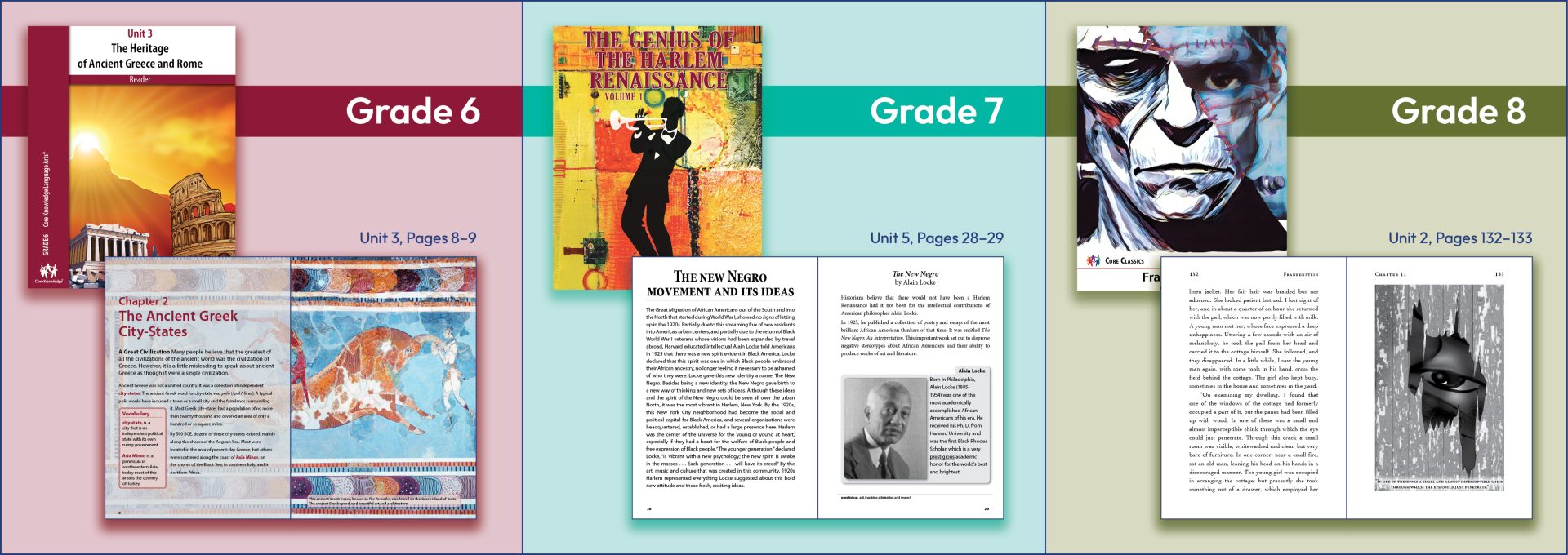
The Activity Book contains Activity Pages to accompany the lessons from the Teacher Guide.
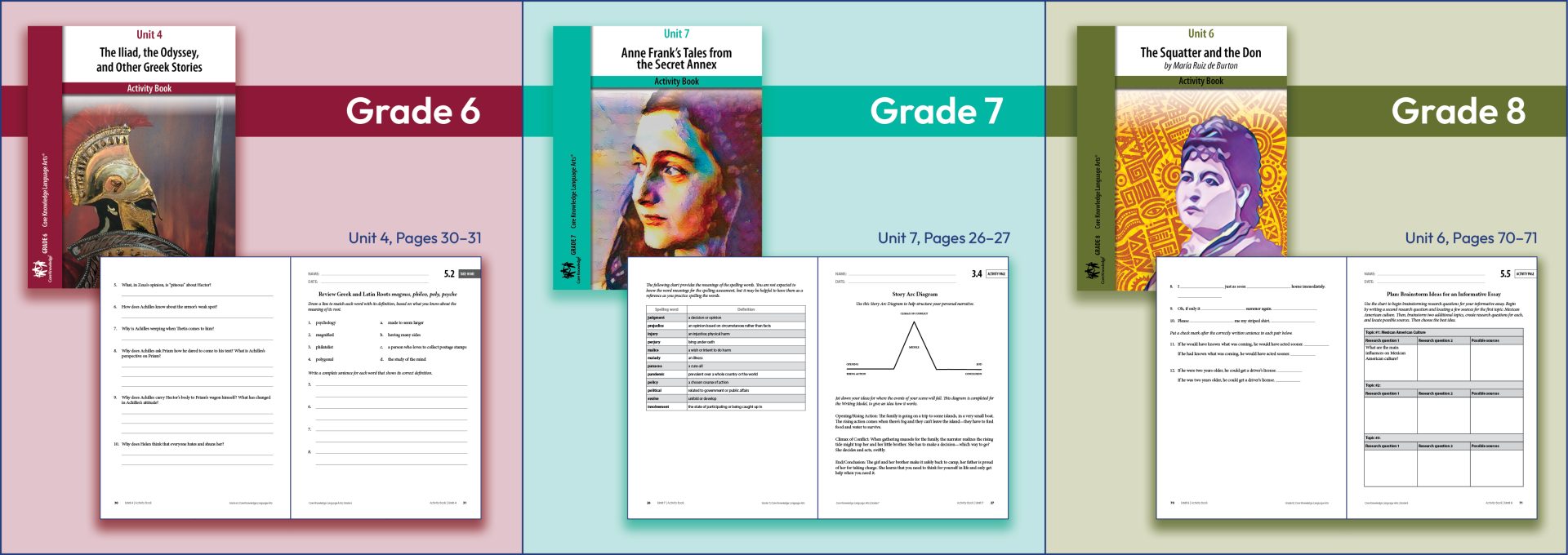
Teacher Guides include detailed guidance and activities for reading, discussion, and writing.

The Teacher Guides for CKLA reference various online resources to support the teaching materials. Links to these websites may be found in the Online Resources document.

Core Classics Series
In our Core Classics® Series, we present stories loved for generations in abridged versions for young readers, faithful to the style, plot, and themes of the originals. The texts support and reinforce knowledge from the CKLA curriculum.
Core Classics are suitable for reading aloud in the upper elementary grades. For middle school students and older, the texts are appropriate for independent reading.
Biography Series
Voices in History is a Core Knowledge Biography Series that encourages young readers to learn about real superheroes in history. As a result of acts of extraordinary bravery, ingenuity, strength, and determination, these people made a difference and changed the world. Perhaps their remarkable stories will inspire young readers to become the superheroes of the future.
Written by award-winning authors, these books are designed to be read independently, or read aloud in a classroom setting. The people featured in this series appear in the Core Knowledge Sequence and in the following curriculum programs: CKLA, CKHG, and CKSci.
These books are suitable for readers aged 8 and up.
- Don Quixote
- Frankenstein
- Gulliver’s Travels
- The Iliad and the Odyssey
- The Importance of Being Earnest
- King Arthur and the Round Table
- The Legend of Sleepy Hollow
- Little Women (a Core Classics Plus® Study Edition)
- A Midsummer Night’s Dream
- Narrative of the Life of Frederick Douglass (a Core Classics Plus® Study Edition)
- Robin Hood
- Robinson Crusoe
- Sherlock Holmes
- The Squatter and the Don
- Strange Case of Dr. Jekyll and Mr. Hyde
- The Tempest
- The Time Machine
- The Tragedy of Julius Caesar
- Treasure Island
- Twelfth Night
Related Curriculum
CKLA follows our approach to knowledge-based schooling, outlined in the Core Knowledge Sequence. It allows students to build and deepen their knowledge grade by grade and to make cross-curricular connections across subjects.
Implementation Resources
The Core Knowledge Language Arts program provides the tools and resources you’ll need to implement Core Knowledge in your school, including an implementation guide with professional development opportunities, presentations and other useful resources.
Through your implementation process, you may also find it helpful to explore the research on teaching and learning that informed the development of CKLA, along with a range of articles and presentations on the program.
Enriching CKLA with History & Geography Curriculum
Enrich your CKLA lessons with resources from our Core Knowledge History and Geography (CKHG) program. The objectives correlate with the Common Core English Language Arts standards, which call for an increase in nonfiction informational texts. With CKHG in addition to CKLA, you can take an interdisciplinary approach to reading that provides informational texts in a coherent sequence.
Core Classics
In our Core Classics® Series, we present stories loved for generations in abridged versions for young readers, faithful to the style, plot, and themes of the originals. The texts support and reinforce knowledge from the CKLA curriculum.
Core Classics are suitable for reading aloud in the upper elementary grades. For middle school students and older, the texts are appropriate for independent reading.
